Javier Vazquez will take a turn in the starting rotation, replacing Dustin Moseley on Saturday against the Blue Jays, Joe Girardi announced this afternoon. The decision came as little surprise as Moseley has gotten hit around over this last four outings while Vazquez has made two impressive bullpen appearances, flashing better stuff and velocity. Since beating Boston on August 8, Moseley is 2-1 but is averaging fewer than five innings a start. He’s walked 13 and struck out 11 while giving up five home runs en route to a 6.41 ERA. Meanwhile, since losing his rotation spot amidst a dead-arm period, Vazquez has thrown nine strong innings in relief. He’s allowed two runs on four hits and two walks while striking out eight. We questioned whether Vazquez truly tweaked his mechanics or was experience the placebo effect of a new role role, but no matter the answer, the Yanks feel comfortable enough to move him back to the rotation after a two-week stint in the pen.
Yanks open series with 11-5 drubbing of A’s
Heading into last night’s game, Trevor Cahill held the AL’s second lowest ERA, trailing just Clay Buchholz. So when the A’s staked him to a 3-run lead in the first, things didn’t look so good for the Yankees. It took all of five batters to change that outlook. The night continued to get better, and it ended with an 11-5 Yankees victory.
Biggest Hit: Swisher ties it early

For the most part Dustin Moseley has done a good job filling in for Andy Pettitte. He’s had some rough outings, but that’s expected. He is, after all, Dustin Moseley. All the Yanks ask is that he keeps them in the game. From the outset last night it looked like he would fail. Two singles and a walk loaded the bases, and the A’s struck for three before heading out to the field. That had to feel good with Cahill on the mound.
The Yanks wasted no time in evening the score. Gardner started with a walk, Teixeira followed two batters later with a single, and then Robinson Cano brought home the first run with a single of his own. That ball was so well struck that even though Mark Ellis was in a position to field it, he just couldn’t make the play. That brought Nick Swisher to the plate, and Swisher delivered.
Cahill delivered five sinkers during the at-bat, but only one of them ended up down in the zone — Swish took that one for ball two. The sequence went ball, foul, ball, ball, foul, double to deep center. Coco Crisp made a valiant effort, but the ball went beyond his outstretched glove. It took him a moment to recover, which gave Cano enough time to score from first and tie the game.
In a span of just five batters the Yanks turned this from a frustrating game into a new game. That’s what happens when you have such a high-powered offense.
Meet Saturday’s starter

When Moseley walked Kurt Suzuki in the fifth he accomplished two things. First, he guaranteed that Girardi would take him out of the game. The last pitch hardly had time to cross the plate before Girardi was out of the dugout and on a brisk jog to the mound. Second, he opened the door for Javy Vazquez’s return to the rotation. For the next 4.2 innings, Vazquez made his case clear.
It took a Jeter jump toss to get out of the fifth, but from there Vazquez had things under control. He started the game by retiring seven straight and allowed just one run on two hits, striking out six. He even hit 90 consistently. Though, for what it’s worth, Moseley’s final pitch was also 90 mph.
Moseley’s next turn in the rotation would come on Saturday, but I’d bet on Vazquez slotting in there. It seems like a good time to see if he can be that guy he was from May into July. That will be a big boost to a rotation going through a rough patch.
Filling in for A-Rod

Marcus Thames hit his 10th home run of the season this year, though it certainly feels like he’s hit more than that — probably because he’s hit six in his last six games. The tear comes at a great time. It’s like not losing Alex Rodriguez at all. In fact, since A-Rod’s injury Thames is 11 for 34 (.324) with three walks (.432 OBP) and six home runs (.765 SLG).
Mark Teixeira, too, has been cruising along since A-Rod started missing time. He was 3 for 3 with a walk last night, and is 14 for 41 (.342) with six walks (.429 OBP) and seven extra base hits (.659 SLG). He and Thames have made missing A-Rod not as big a deal as it could have been.
Miscellany

Brett Gardner got on base three times and didn’t score. You won’t see that happen often.
How many young pitchers have we see throw 100 mph? How many of those pitchers sustained that speed? How many of them lasted long-term? Sorry, Henry Rodriguez, but you are no Billy Wagner.
Swisher is back up to .298, for those of you who are still holding out hope that he’ll finish the season at .300.
Trevor Cahill has allowed 50 earned runs this season. The Yankees have 14 of those.
Graph and Box
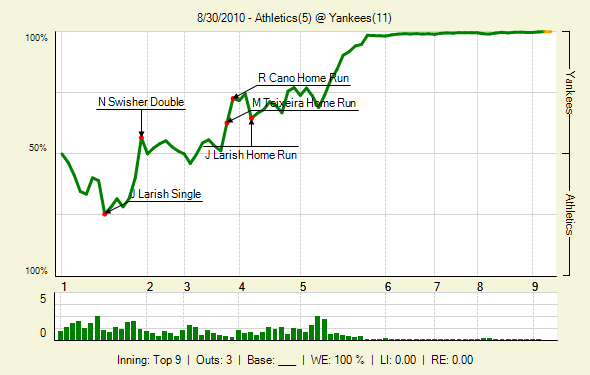
More at FanGraphs. You know, FanGraphs has the box score, too. But just in case you like ’em simple, here’s the regul’r box score.
Up Next
Phil Hughes attempts to recover from a poor start, while Vin Mazzaro starts for the A’s. Considering the sparse crowd last night, I’m sure Mazzaro will be able to get all of his buddies into the game.
With Pettitte out until Sept., a pitching problem
Andy Pettitte, 11-2 on the season with a 2.88 ERA in 18 starts, last pitched on July 18 after ten days of rest due to the All Star break. During that game against the Rays, Pettitte strained his groin, and although the team had hoped he would return within six weeks, the southpaw has been slow to heal. After a setback last week, the Yankees do not expect Pettitte to return until early September, and the Yanks have the makings of a pitching problem.
Pettitte and the Yanks unveiled the bad news about Andy’s groin last night. The lefty had gone for an MRI Tuesday night as he still felt pain in his legs, and the results were discouraging. The imaging scan revealed what the Yanks called a “small, persistent strain of the left groin, and Pettitte will rest for a week. Once he ramps up his rehab again, he’ll need to make two Minor League starts, and the Yankees do not see him returning until around September 10. “It’s going to end up, right now, at least seven weeks, and that’s longer than we anticipated,” Joe Girardi said to reporters.
Pettitte worries that he, at age 38, may not pitch again, but he seems to blame himself for the extended absence. He says he pushed too hard early on to get back into pitching shape. “To say I’m frustrated, that’s an understatement,” Pettitte said. “I’m trying to stay as positive as I can, but I want to pitch. I just want to get back and I want to pitch and I want to be healthy.”
The Yankees know that readying Pettitte for the playoffs is their primary concern, but getting there might become an issue. The club is locked in a battle with the Tampa Bay Rays for first place in the AL East while the Red Sox just won’t die. Boston is sitting 5.5 games out of first — six on the loss side — with 12 games left against the Rays and Yankees. The Bombers have their work cut out for them, but do they have the pitching pieces they need?
After last night’s game, Dustin Moseley’s immediate role on the team is hazy at best. He threw what I would call an adequate five innings against the Detroit Tigers. I’m willing to forgive him the two home runs to Miguel Cabrera, but after a reasonably strong start, Moseley faded by the fifth. He threw a bunch of change-ups, sinkers and curveballs, but with only a four-mile-per-hour separation between the change and fastball. He hit 90 only a few times and topped it just once. His stuff is mediocre at best.
For Moseley, his biggest problem is that he doesn’t miss bats. Tigers’ hitters swung and missed at just eight of his 84 pitches last night, and despite a 3-2 record, he has an ERA of 4.76 and an unimpressive 19:14 K:BB ratio in 39.2 innings. He’s also allowed a whopping nine home runs and now has a FIP of 6.15. I know he pitched a gem against the Red Sox, but would anyone really trust him in a key spot right now?
And of course the Bombers still have their Phil Hughes problem. The youngster takes the mound this afternoon with 134.2 innings under his belt and a season limit believed to be around 175. As Larry Brooks of The Post notes, Pettitte’s injury is impinging on the Yanks’ plans for Hughes. The team doesn’t expect to pull Hughes from the rotation and certainly won’t do so with Pettitte out. But they could be risking a big jump in Phil’s innings if the Red Sox continue to put pressure on the AL East leaders and Pettitte’s injury lingers.
At this point in the season, the Yankees have few options. Shadowing Moseley at AAA, Ivan Nova gave up a run on five hits in 6.2 innings. He struck out seven but walked four, and with a 12-3 ERA with a 2.86 ERA, he could be in line for a few Bronx starts. His Minor League equivalences before last night show a FIP of 4.78 and an unimpressive 1.6 K:BB rate.
For now, then, the Yanks will move ahead with a hole in their rotation. They’re probably rely on the bullpen to get 12 outs if Phil Hughes is pitching in some blowouts, and they’re cross their fingers that Andy gets well soon and that his replacement can keep a lid on the runs. After all, as Brian Cashman said after last night’s win, “You can’t replace Andy Pettitte.”
After the rain, Yanks drop a close one to KC
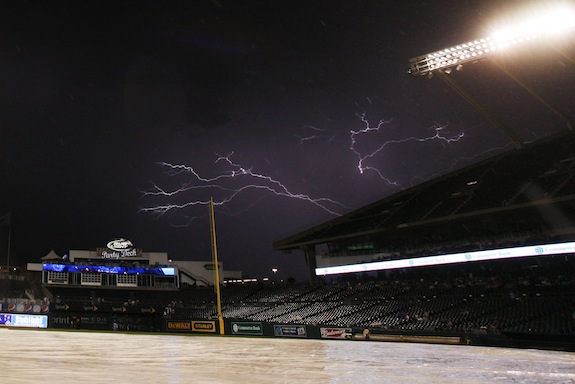
For the second time this season, the Yankees and Royals sat through a lengthy rain delay, but for the Bombers, the payoff wasn’t worth the two hour and ten minute wait. Despite a ninth inning threat against Joakim Soria, the Yanks couldn’t get a big hit, and Billy Butler’s 5th inning home run stood as the winning run in a 4-3 game. The Yanks played their fifth one-run game in a row, and as Tampa Bay and Boston both lost, the AL East playoff picture stays static for another day.
The Bad: Dustin Moseley and the Curse of the RISP
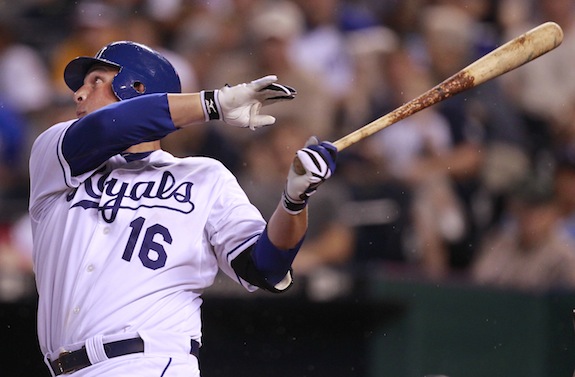
After three solid starts and a one-hit relief appearance against the Royals last month, Dustin Moseley couldn’t command his stuff. It took him nearly 60 pitches to get through the first six outs of the game, and the Royals plated three runs on a double and a bunch of seeing-eye singles in the bottom of the second. Moseley settled down a bit after that, but a Billy Butler home run with one out and rain falling in the fifth doomed the Yanks.
Moseley ended up with the loss after a 4.1-inning outing cut short by the weather. He allowed eight hits and three walks while striking out just one, and some nifty defensive work behind him prevented the Royals from breaking the game wide open. The bloom has come off his rose a bit, but the Yankees, meanwhile, had their chances. They went just 3 for 15 with runners in scoring position with all three of those hits coming in the third inning. From the fourt inning on, they were 0 for 8 with runners in scoring position. After the rain delay, it seemed as though the teams were just going through the motions when play resumed at 11:30 p.m. central time.
After returning from the rain delay, the Bombers made a late go of it against Joakim Soria. The young Royals relief stud allowed a single by Derek Jeter. Then, Curtis Granderson laid into two pitches. The first was pulled foul, and the second was a shot to the warning track in left field. After Mark Teixeira struck out, A-Rod singled up the middle, but Jeter could make it only to third.
That Jeter was still only on first when A-Rod was up remained a mystery to me. Soria isn’t particularly fast to the plate, and Jason Kendall, with a league average caught stealing rate, isn’t a particularly adept thrower behind the plate. The Yanks had to put themselves in a position to tie the game on a single, but Jeter never stole. With runers on first and third, Robinson Cano bounced out to second to end a long game.
The Good: Brett Gardner’s Arm and the bullpen
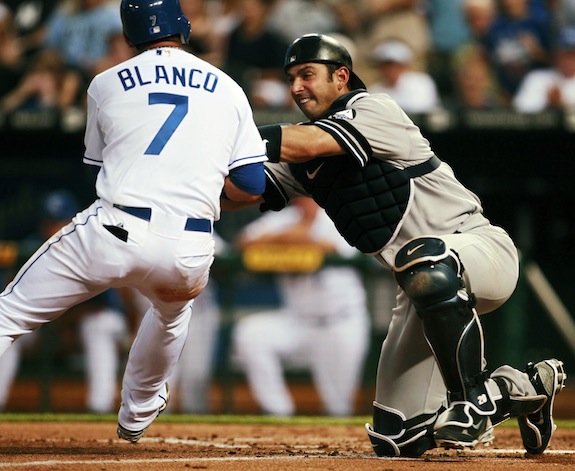
Despite the outcome, Brett Gardner and the bullpen deserve some praise. In the first inning, Gregor Blanco singled and later stole second. Billy Butler bounced a base hit between short and third, and as Blanco rounded third, Gardner came up throwing. He mailed a perfect one-bounce throw to Jorge Posada to nail Blanco. As Posada held onto the ball — but not his glove — Gardner earned his ninth assist of the season.
Also of note was the relief work today. After Dustin Moseley’s start was cut short by the rain, Chad Gaudin, Kerry Wood, Boone Logan and Joba Chamberlain combined for 3.2 innings of scoreless, hitless baseball. The only base runner the Royals managed after the rain delay came on a walk issued by Gaudin to restart action in the 5th. Logan hasn’t allowed a lefty to reach base since the end of June when he hit Ichiro with a pitch, and Wood has been impressive since arriving from the Indians.
Box Scores Galore
After Jeter’s ninth inning single, the Yanks’ win expectancy was still around 30 percent, but it just went down from there.

Up Next
It’s a Saturday night special, as Phil Hughes (13-5, 3.92) faces off against Sean O’Sullivan (1-3, 5.05) at 7 p.m. Eastern time. If that match-up seems familiar, that’s because these two pitchers have already faced each other twice this season. Rain is thankfully not in the forecast.
Pettitte, Moseley and Phil Hughes’ innings
After tossing six innings yesterday afternoon against the Red Sox, Phil Hughes had accrued 128.2 innings on the season in 21 starts. He’s averaging just over six innings per outing, and as his current pace, as ESPN’s Ian Begley noted, he’ll reach his soft innings limit of 175 at around September 18 in Baltimore with two weeks of the regular season and the October slate remaining. The Yankees will have to be creative to get the most out of the right-hander who has emerged as the team’s third best starter.
Already this year, we’ve seen how the Yankees plan to get the most out of Hughes. They’ve skipped his starts twice but with less than stellar rests. On four or five days’ rest, Hughes is 12-3 with a 3.35 ERA in 113 IP. In just three starts following six or more days of rest, Hughes is 1-2 with an 8.04 ERA, and in those 15.2 innings, batters are hitting .367/.451/.650. Notwithstanding the small sample size, those results are like night and day.
The Yankees, we know, would love to skip Hughes a handful of times. His start against the Royals next weekend, for one, seems largely unnecessary because the Yanks could beat the Royals without Hughes on the mound. They’d rather just use him for the key starts down the stretch. Hughes, though, prefers to be a creature of habit. “That’s what I’m used to,” he said of pitching every five days. “Just going out and getting the ball and doing my normal schedule. But if they feel like something needs to be adjusted in that way then that’s up to them.”
He doesn’t, however, think his struggles were anything more than a coincidence. Nothing, he said, felt physically wrong when he was pitching on extended rest. Still, the narrative runs strong here, and the results, so far, have been widely divergent. Hughes, as with any starter, thrives on regularity.
How then can the Yankees limit Hughes’ workload without giving him too much rest? The answer should lie with Dustin Moseley and Andy Pettitte. Yesterday prior to the Yankees/Red Sox affair, Pettitte threw a simulated inning in the bullpen. He threw 20 pitches and felt only fatigue and not pain in his injured groin. He’ll throw another simulated game on Thursday before heading out on a rehab assignment for one start. He could be back by the time the Yankees play the Mariners at home next weekend, but the Yankees are going to be cautious with Hughes.
And then, we have Dustin Moseley. Through 30 innings with the Yanks, Moseley has been more than adequate. His strike out totals — 16 with a K/9 IP of 4.7 — are low, but opponents are hitting just .239/.303/.413 off of him. His 1.50 ground out-to-fly out ratio allows him to succeed without a high strike out total, and the Yankee scouts have been high on his sinking pitches. He’ll draw the Royals later in the week.
With these three pitchers in play, the Yankees have six legitimate starters, and the opportunity to use them all. They could employ an abridged six-man rotation, giving Hughes and Pettitte extra days when necessary but keeping Sabathia and Burnett on track. Moseley would act as the swing man, and Hughes’ innings could be stretched out by another week or so.
What the Yankees can’t do, however, is shut down Phil Hughes. There isn’t enough time to ramp down his innings and then ramp them back up before the playoffs, and as Joba Chamberlain showed last year, that strategy wasn’t quite effective. So the team will have to get creative with the rest. With Moseley, the team has the flexibility to rest Hughes or extend his time between starts, and that’s a luxury that could be a key factor come the stretch drive.
Moseley’s odd pitch locations
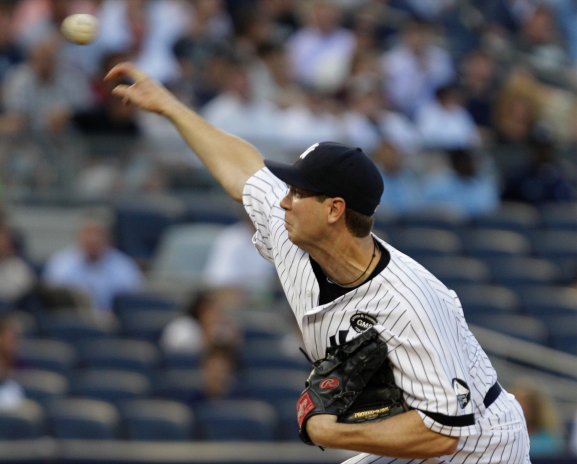
It is clear from the first pitch you see that Dustin Moseley won’t overpower anyone. His fastball averages around 88 mph, topping out at 90, 91, depending on the night. A pitcher like that requires precision with his pitches. If he leaves one of those over the plate, major leaguers are going to hit it hard. Since the Red Sox didn’t hit him hard last night it might seem like he located balls in favorable spots. But after looking at the data this does not appear to be the case.
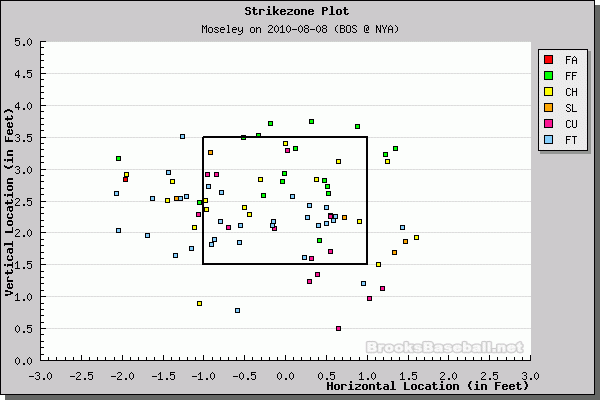
This chart, supplied by Brooks Baseball, looks odd for a guy who doesn’t blow pitches by hitters. It looks odder still for a pitcher who got 12 grounders out of 19 balls in play. Normally when we see a flurry of ground balls we also see pitches, particularly two-seamers, low in the zone. Moseley, it appears, worked in the lower half, but generally didn’t hit the bottom quarter of the zone with his groundball-inducing pitch.
Instead, we see a belt of two-seamers that crossed around the middle of the zone. Thankfully only three of them were above the mid-point. The rest were below, though not by a lot — again, in one of the middle quarters. For a guy who requires groundballs to perform his job well this might seem like a hindrance. But the Red Sox hitters seemingly could not connect with the two-seamer no matter its location. When they did, it was mostly on the ground. Of the 26 batters Moseley faced, 15 saw a fastball with the final pitch and they broke down like this:
2 walks
4 strikeouts (3 looking)
2 liners (1 base hit)
7 ground balls
Not bad for an 88 mph fastball that crossed, for the most part, near the middle of the zone. The key, it appears, is the movement he puts on the pitch. In 2003, when he ranked No. 4 on the Reds prospect list, Baseball America noted that, “he has plus movement and manipulates the ball to both sides of the plate with a cutter and a two-seamer.” The cutter, it appears, has been scrapped in favor of a slider, but the movement on the two-seamer remains.
Baseball America also notes the effectiveness of his 12-to-6 curve and his changeup, both of which remain in his arsenal. Last night he threw 18 changeups, 10 of which were strikes. According to PitchFX it traveled about 5 mph slower than his fastball, with about half the horizontal break and obviously a lot less on the vertical axis. He didn’t generate any swings and misses, but he did get five batters to put the ball on the ground weakly, one to pop up, and the other to gently fly out. Otherwise he used it to set up batters, and it was quite effective in that regard. According to linear weights it was by far his most effective pitch of the evening.
What I find most odd about Moseley’s start is that despite the lack of a power fastball he still relied on the pitch. PitchFX separated the pitch into four-seamer and two-seamer, but the movement and speed on both seem identical, so I’m sure he wasn’t doing much different with them. All told he threw 50 fastballs, 18 changeups, 14 curveballs, and five sliders. It was an effective mix, as the results showed. The Sox hardly made quality contact, as even the bulk of their base hits came on ground balls. If Moseley can continue attacking opposing offenses like that he’ll have some kind of role on this team.
Last night the Yanks got all they could have expected out of Dustin Moseley. He took advantage of a slumping offense and pitched six and a third strong innings. It came in a strange way, getting groundballs on pitches that were near the middle of the zone. But it worked. He might not be Andy Pettitte, but in his place Moseley has thrown 24.1 innings to a 2.96 ERA. Not bad for a guy who this past off-season was non-tendered by the pitching-shallow Angels.
A close game early gives way to a blowout late
For a few hours, tonight’s 11-4 route of the Indians had a tense feel to it. Tampa Bay had downed the Tigers earlier in the afternoon, and for the Yanks to head into their AL East showdown with a comfortable lead, the Bombers had to beat Mitch Talbot and the hapless Indians. Through five innings, the two clubs were locked in a 1-1 tie, but then the Yanks busted out for seven runs in the seventh. Even an adventurous ninth inning meant little for the Indians, and the Yanks walked away winners of three of four in Cleveland and six of eight against the AL Central bottom feeders.
Moseley mows ’em down
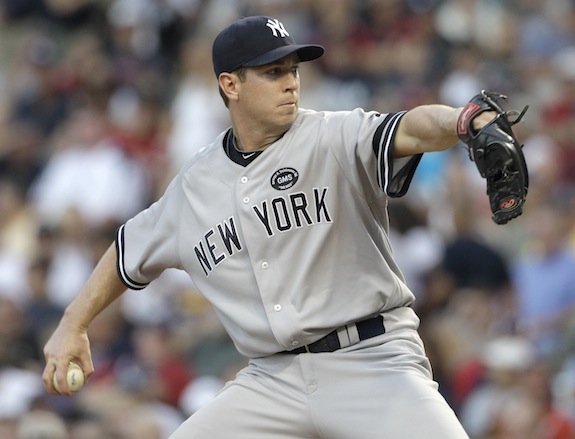
Before we delve into tonight’s offensive orgy, we start on the mound with Dustin Moseley. The 28-year-old righthander drew the start in place of Sergio Mitre who pitched poorly five days ago in place of Andy Pettitte. Moseley didn’t start as a direct response to Mitre’s results over the weekend, but he started because the Yanks realized they hadn’t adequately prepared Mitre for a role as a starter. He rehabbed as a short reliever and didn’t have the stamina to start.
So tonight was Moseley’s night, and at first, it appeared as though he would break long before Mitre did. Although he recorded an out on a fielder’s choice, the first four Indians reached base against Moseley, and a sac fly made it 1-0. With runners on 2nd and 3rd, Moseley struck out Matt LaPorta to halt the damage, but he had thrown 30 pitches in that first inning. He was not, it seemed, long for the game.
But then it all clicked for Moseley. Over the next five innings, he allowed no runs on three hits and a walk and struck out three. He used just 53 pitches for the final five frames and would have returned to the mound for the seventh but for the Yanks’ endless top of the inning. It’s true that the Indians are not a strong offensive club, but Moseley shut them down while the Yanks’ bats went to work. If anything, he’ll draw a start against Toronto next week and should be able to hold down the fort until Andy Pettitte returns.
Jeter breaks the dam
As Moseley kept the Indians at bay, the Yankees couldn’t get much of anything going. Through the first five innings, the enjoyed ten baserunners and plated but one solitary run. Up on that scoreboard at Progressive Field, it was the loneliest number until Number 2 knocked in a row. With two outs in the 6th, Jeter ended the Yanks’ 0-for-10 span with runners in scoring position and as the Yanks had their 2-1 lead, the game quickly became a blowout.
In the seventh inning, everyone hit. After two quick outs, the next 10 batters went a combined 4 for 5 with four walks and a hit batter. Cano hit a booming home run to left — his 20th of the year; Francisco Cervelli knocked in a run; Derek Jeter walked to force in a run; Curtis Granderson singled in two; A-Rod, homerless again, singled in two. By the end of the game, the Yanks were 7 for 21 with runners in scoring position, a far cry from that 0-for-10 stretch.
In truth, the big blow always seemed just around the corner. Mitch Talbot had to leave the game in the third with a stiff back, and the Indians had to rely on their bullpen to get 21 outs. It couldn’t, and the Yankees, as good times are wont to do, took advantage of the parade of lesser pitchers who passed through the mound.
They told me to walk this way

Despite the 11 runs, the Yanks could have scored more quite easily. In addition to their early-game struggles with runners in scoring position, the Yanks eked out 12 free passes from Indians’ pitchers. In total, the Yanks had 25 baserunners, and all of the starters except for Francisco Cervelli reached base at least twice. This Cleveland club is a far cry from the near-AL Champion 2007 squad.
Amusingly enough, the only Indians pitcher who didn’t issue a free pass was a position player pressed into service. Andy Marte came on to pitch The Eighth Inning. He induced a grounder from Cano, struck out Nick Swisher and got Marcus Thames to line out to third. It was a job well done by the best hurler on the Cleveland staff.
Adventures in CHoP-land
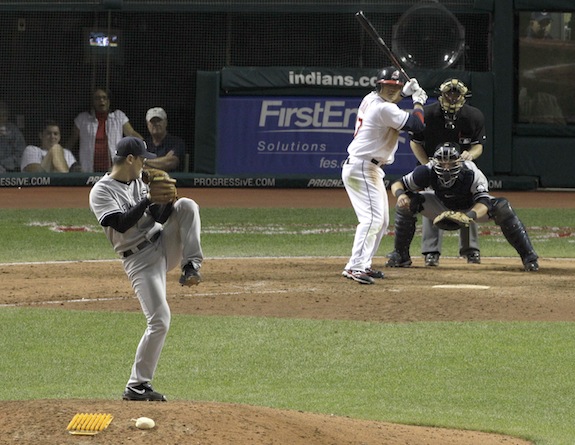
Finally, we arrive at the Chan Ho Park Ninth Inning Debacle. With the game so firmly in the Yanks’ pocket that Joe Girardi thought it clever to put Marcus Thames at third base, Chan Ho Park came unglued. He recorded three quick outs in the 8th and two outs in the 9th before he just lost it. He walked Chris Gimenez and Austin Kearns, and then after running the count full, he allowed an RBI single to Matt LaPorta.
Then, the real fun began. Jayson Nix hit a hot shot to third that Marcus Thames gloved. But when he tried to make the long throw across the diamond, he airmailed it into the stands. It was a toss worthy of Keith Olbermann’s mom, and all of a sudden, Girardi’s cute idea seemed costly. Park gave up another walk before Luis Valbuena sent Nick Swisher back to the warning track as he hauled in the final out of the game.
I can’t fault Park for this performance to the extreme I usually do. He threw over 50 pitches and would have gotten out of the inning if not for Thames’ fielding. Still, at one point, he had thrown 11 straight balls in what was a 10-run game. That’s not pitching to inspire confidence. All’s well that ends well though.
Looking closer than it was

You’ve got your Fangraphs box and your ESPN box.
Up Next
The Yanks take their two-game lead into the Tampa Bay area later tonight. Phil Hughes will face Wade Davis to start a key three-game match-up with the second-place Rays. After a week of the Indians and Royals, the intensity will ratchet up a notch during this weekend’s sold out set.